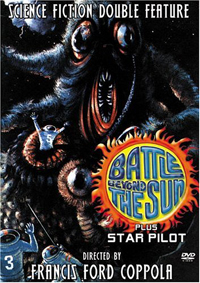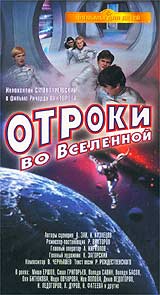
Iakov Protazanov's film Aelita (1924) has gone down in history with the interesting honour of being the first Soviet science fiction film. Critics have most vividly remembered its expensive Martian scenes with futuristic and Constructivist sets and costumes by Alexandra Ekster and Isaak Rabinovich and the infamous passage where the protagonists start a proletarian revolution on Mars. However, it is only really in the last decade that it has been understood that film is rather at odds with its reputation, and in reality it is neither science fiction nor a pro-revolutionary film.
The majority of the film is set in Moscow, where the action begins, develops and has its ultimate resolution. What action does occur on Mars is eventually shown to have been illusory and a result of hero's dissatisfied imagination, giving an end feeling of it being more of an anti-climatic non-science-fiction film if anything. Furthermore - as we shall see - the film may be pro-Communist but it has a decidedly anti-revolutionary feel about it, which goes in some way to explain the failure of the film with critics at the time. Aside from doubts about the film's commitment to the revolution, contemporary film-makers were scathing about the film's alleged continuity with the bourgeois cinema of the Tsarist age.
Despite heavy criticisms at the time from official Soviet critics, Aelita emerges today (largely due to a pioneering reading of the film by Ian Christie) as a highly complex film that holds as many breaks with pre-revolutionary cinema as it has continuities [1]. It engages with a number of themes and styles and attempts to bring them together within a sophisticated plot which comments on the social, political and historical reality of 1920s Russia, as well as providing audiences with a ripping yarn.
To bring these themes together Protazanov employs a series of interlinking metaphors centring around images of differing times, differing spaces, journeys between these spaces, substitution and doubling, building and change, and oppositions between domestic life and fantasy. It is within this context that the film draws on the realm of science fiction - not as an end in its own right, but as part of Protazanov's rich metaphoric language to talk about earth-bound affairs.
http://www.imdb.com/title/tt0014646/
ed2k: Aelita_byDAD111_RUS.ogm [674.15 Mb] [Stats]
--
Doroga k zvezdam

Road to the Stars was one of the most amazing special effects accomplishments in film history. Pavel Klushantsev began working on the colour film in Leningrad in 1954. His aim was to explain and realistically portray the coming age of space exploration. With technical advise from Tikhonravov (who was secretly developing the Soviet Union's first manned spacecraft at the time), Klushantsev showed tremendous ingenuity in explaining and portraying man's conquest of space. The film was nearing completion when Sputnik 1 was launched. Klushantsev hurriedly filmed a sequence illustrating this feat, and the film was released internationally a month later.
The special effects were very ambitious and many scenes are reminiscent of the 2001 space station and Moon colony segments, though the film predated 2001 by a decade.
http://us.imdb.com/title/tt0052138/
ed2k: Doroga%20K%20Zvezdam%20(Xvid%20Rus)%20Bu%20Forum%20Xvid%20Ru.avi [237.99 Mb] [Stats]
--
Nebo zovyot

Battle Beyond the Sun. Roger Corman (Producer of US version), Francis Ford Coppola (re-edited version with new footage)
Battle Beyond the Sun (1962) is an elaborate butchering of a Russian film called Nebo zoyvot (1960) and one of Francis Ford Coppola's earliest screen credits. While gadding about Europe producing movies on a shoestring, Roger Corman picked up the rights to several unsold European genre pictures, including what looks to have been a sober and moralistic movie about the need for cooperation between the U.S. and the U.S.S.R.. The Russian rocket Potemkin aborts its Mars mission to rescue two foolish Americans from their craft Typhoon, after they unsuccessfully attempt to beat the Russkies to the red planet.
The Russian visual effects are excellent for their year, with interesting designs for the orbital space station and clever mattes. Acting and direction are merely functional but there are good details like the space station's botanical garden to generate oxygen, and a tense meeting of opposing scientists that is almost identical to the stiff interaction seen in Kubrick's later 2001: A Space Odyssey. Naturally, the 'Russian' side is open and friendly, while the 'Americans' are sneaky and dishonest. The original makers of Nebo zovyot (which translates as "The Heavens Call") must have been dismayed to see their movie and its message twisted into a kiddie flick about giant space blobs on a Martian Moon.
http://us.imdb.com/title/tt0053103/
---
Planeta Burg

"Planeta Bur" is about cosmonauts who are lost on Venus, attempting to return to the spaceship, and their adventures along the way, which include encounters with prehistoric reptiles, a volcano, and other perils. Like Ptushko's "Sadko", this is a true gem of fantastic film. The use of natural and artificial sets is very effective in creating an atmospheric, alien world; the monsters (an intelligent robot, a carnivorous plant, pestiferous lizard men, a pterodactyl, and some other dinosaurs) are similarly well done. Unlike American films of this kind, there is no emphasis on macho violence or digressions into "steamy" romance scenes; instead the film concentrates on the lavish visuals in an unhurried and dignified pace. My only complaints are that the introduction is too long and slow-moving, and that the subplot involving Masha's agonizing over the fate of her comrades isn't very interesting; but the scenes on Venus, which comprise the bulk of the film, more than make up for these flaws. "Planeta Bur" was drastically edited by Peter Bogdonavitch and released in the States as "Voyage to the Planet of Prehistoric Women"; two versions exist, one with footage of Mamie Van Doren leading a tribe of telepathic Venusian women and worshipping the pterodactyl of the original film, the other without Ms. Van Doren or any of the prehistoric reptile footage.
http://spanish.imdb.com/title/tt0056352/
ed2k: planeta.burg.(planet.of.storms).avi [702.35 Mb] [Stats]
ed2k: Planeta%20bur.avi [699.84 Mb] [Stats]
subs (eng-cas): http://anonym.to/?http://www.extratitle ... rid=174696
---
Chelovek Amfibiya

http://spanish.imdb.com/title/tt0055844/
ed2k: Chelovek-Amfibia.avi [704.18 Mb] [Stats]
ed2k: Chelovek-amfibiya.1.(DVDRip.XviD.rus).SharElita.com.avi [695.99 Mb] [Stats]
ed2k: Chelovek-amfibiya.2.(DVDRip.XviD.rus).SharElita.com.avi [700.32 Mb] [Stats]
---
Giperboloyd inzhenera Garina

Set in the mid-1920s, the picture revolves around a death ray which falls into the hands of the crazed Yevstigneyev. After stealing the blueprints from his teacher he decides to use the machine for villainous purposes, until the state intervenes.
http://us.imdb.com/title/tt0314105/
ed2k: Giperboloid%20inzhenera%20Garina.avi [623.69 Mb] [Stats]
---
Yego zvali Robert

A constructor Sergei creates a robot Robert as his own copy. Tanya teaches Robert to feel and the robot becomes more human than his rationalistic creator...
http://us.imdb.com/title/tt0062508/
---
Tumannost Andromedy

This is a classic communist utopia set in a distant future. Throughout the novel, the author's attention is focused on the social and cultural aspects of the society; there are several principal heroes (a historian, an archeologist, a starship captain) involved in several lines of action. Though the world shown in the novel is portrayed as ideal, there's an attempt to show a conflict and its resolution with a (voluntary) punishment of a scientist whose reckless experiment caused damage. There's also a fair amount of action in the episodes where the crew of a starship fight alien predators.
Several civilizations of our Galaxy, including Earth, are united in the Great Circle whose members exchange and relay scientific and cultural information. Notably, there's no faster-than-light travel or communication in this world, so interstellar missions sent by Earth are few and can only reach close stars, and the Great Circle civilizations almost never meet in person. The Great Circle radio transmissions are pictured as taking the energy of the whole Earth and therefore infrequent; one of such transmissions is a lecture on the history of the Earth civilization which gives the author an opportunity to put his world into a historic context.
Critics have accused this novel of being overly dry and illustrative, its heroes being more of philosophical ideas than live people. Nevertheless, the novel was a major milestone in Soviet sci-fi literature, which before that was much more short-sighted (never venturing more than a few decades into the future) and focusing on technical inventions rather than social issues. It has been said that the booming Soviet sci-fi of 1960s, including such authors as Strugatsky brothers, would have been impossible or at least very different without this breakthrough novel.
The Andromeda Nebula (1967), most of which were purchased and re-edited by Roger Corman. Even though the Soviet filmmakers were not permitted to view the American films at the time, there is almost no difference between one of these Soviet depictions of a space mission and an American one.
http://www.imdb.com/title/tt0278781/
ed2k: Tumannost_Andromedy.avi [699.98 Mb] [Stats]
ed2k: Tumannost_Andromedy.ENG.sub [30.6 Kb] [Stats]
---
Solaris

http://akas.imdb.com/Title?0069293
---
Moskva-Kassiopeya

In this children's sci-fi adventure, a crew of adolescents are sent to a distant star within the constellation Cassiopeia in the hopes that by the time they arrive as adults. However, they reach their destination much sooner than expected, and various teenage problems get in the way
http://us.imdb.com/title/tt0070413/
ed2k: moskva_kassiopeya.rus.ruvideo.avi [677.60 Mb] [Stats]
---
Otroki vo vselennoy

The second part of 'Moskva – Kassiopea'(1973) which ended when the young scientist cum space crew,all under 15 years of age, reached Alpha in the constellation of Cassiopea. There they discover a new planet ruled by robots who maintain their human subjects in a state of permanent vegetable.
The children manage to free the people by shortcircuiting the robots, thus restoring everybody to their normal neurotic selves. As a parable, the message is transparent and wittily castigates a ruling elite for its authoritarian paternalism, however benevolent. The mission controller finally orders the kids back to Earth
http://us.imdb.com/title/tt0071957/
ed2k: otroki_vo_vselennoy.rus.ruvideo.avi [650.29 Mb] [Stats]
[ Add all 12 links to your ed2k client ]





.gif)












